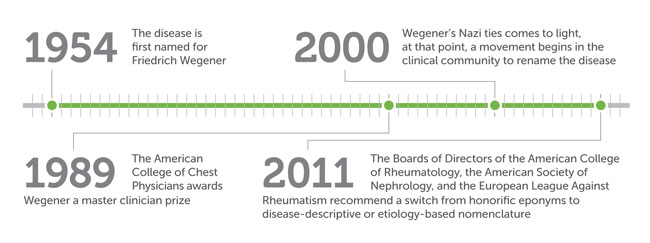What’s in a name? How Wegener’s granulomatosis became GPA

Simple logic would dictate that naming a disease after a physician with confirmed Nazi associations would be met with resistance in the medical community. But when that disease was named before it was known that the clinician was part of the Sturmabteilung, or SA, the issue becomes somewhat more complicated. Such is the case with granulomatosis with polyangiitis, previously known as Wegener’s granulomatosis, initially named after German physician Friedrich Wegener.
Physician and history buff Eric L. Matteson, MD, professor of medicine in the division of rheumatology at the Mayo Clinic College of Medicine and Science, explained the complicated scenario on Healio’s Rheuminations podcast. “Friedrich Wegener was a physician pathologist who trained pre-World War II, but during World War II he was a member of the brown shirts, or SA,” he said. “He was assigned as chief pathologist in occupied Poland.”
Specifically, his post was in the city of Lodz, which Matteson pointed out is the site of the first enclosed ghetto the Nazis created for Jewish citizens. “It is only about 30 miles from the first extermination camp,” he added. “It emerged that, as health officer for that ghetto . . . he oversaw a couple of other physicians who were known to be doing medical experimentation. But, of course, it was not really experimentation, because it was done on victims of oppression, the ghetto inhabitants.”
After more thorough investigation, Woywodt and Matteson published a paper in Rheumatology in 2006 that more fully described the life, both inside and outside of the clinic, of Wegener. Matteson allows that it was not clear that Wegener himself was involved in the experiments, but he was certainly there at the time.
What is verifiable is that Wegener's mentor, Martin Staemmler, vocally supported racial hygiene, according to the paper. Other findings showed that Polish authorities placed Wegener on a wanted list, to the point that they forwarded his information to the United Nations War Crimes Commission. “Unfortunately, later on, when it was decided to call this Wegener’s granulomatosis, he never really said what his responsibilities were at that time [of the war],” Matteson said.
The problem with eponyms
The disease was named for Wegener in 1954. However, Matteson pointed out that this is problematic for one important reason. “[Wegener] wasn’t the first person to describe the disease anyway,” he said. “It turns out a guy named Fritz Klinger, who, of all things, was a roommate of his at medical school, actually described it first in 1931, which is 5 years before Wegener.”

The disease carried Wegener’s name until 1989, when the American College of Chest Physicians awarded him a master clinician prize.
Then Wegener’s Nazi ties came to light in 2000. At that point, a movement came about in the clinical community to rename the disease ANCA-associated granulomatous vasculitis. Woywodt and Matteson supported this change in their 2006 paper.
The movement came to a head in a 2011 paper by Falk and colleagues in the Journal of the American Society of Nephrology. In the paper, the Boards of Directors of the American College of Rheumatology, the American Society of Nephrology, and the European League Against Rheumatism recommended a switch from honorific eponyms to disease-descriptive or etiology-based nomenclature for several diseases, including Wegener’s granulomatosis. The move was prompted by knowledge of Wegener’s Nazi associations. They suggested “granulomatosis with polyangiitis (Wegener’s)” as the alternative, with an acronym of GPA, along with the parenthetical reference to Wegener, until the acronym becomes more familiar to the clinical community.
“We recognize the difficulty inherent in seeking a replacement term for a long-established disease name for this complex multisystem illness with highly variable clinical presentations,” Falk and colleagues wrote. They suggested that although the “replacement term is neither perfect nor encompasses all aspects of the pathophysiology and clinical spectrum of the disease,” the new term has utility for a number of reasons. Including “granulomatosis” gives a nod to both the history and the pathology of the syndrome, while including “polyangiitis” acknowledges its multi-vascular nature.
Pathology vs. person
Falk and colleagues acknowledged that changing the name of a disease is never an easy proposition, but that the clinical community is likely to make this change in light of the historical background.
For Matteson, the issue is that, as in the case with Wegener and Klinger, it is often not the first describer of the disease who ends up with the name, which is obviously problematic. Another issue for Matteson is that the identification of a disease is rarely accomplished by just one individual. “It is usually a team effort,” he said.
“It is really kind of folly to be naming diseases for individuals,” Matteson continued. “It should be the pathology that describes what is going on. That’s really the key lesson. We can’t say that [Wegener] was involved in activity that was illegal, but certainly he was there on the front lines. What is important is that we have accurate descriptions of the diseases. My lesson is not to condemn but to learn.” —by Rob Volansky
For more information:
Eric L. Matteson, MD, can be reached at 200 First St. SW, Rochester, MN 55905; email: matteson.eric@mayo.edu.
References:
- Falk RJ, et al. JASN. 2011;doi: 10.1681/ASN.2011010081.
- Woywodt A, Matteson EL. Rheumatology. 2006;doi: 10.1093/rheumatology/kel258.
Disclosures: Matteson reports no relevant financial disclosures.
